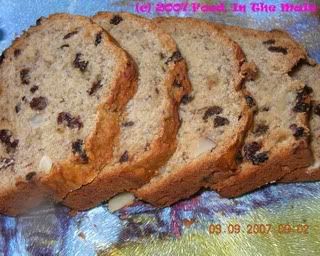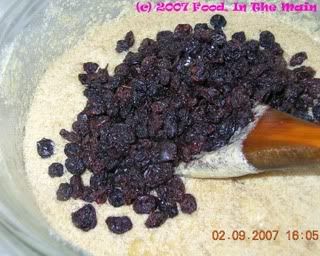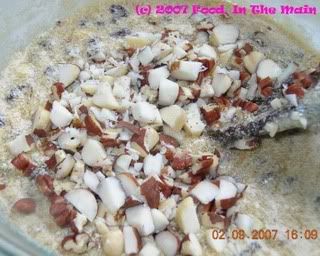skip to main |
skip to sidebar
I don't make sweets often, but once in a while something like Cilantro's fruit kesari catches my fancy, and then it's like a craving - so here's my craving, which I made yesterday. It's just a coincidence that it's Deepavali and the kesari is appropriate as an offering. It's even more convenient that I could use up some over-soft soft fruit that I might have thrown away if not for the craving.
Now if only someone would make me thenkuzhal and thattai...
Ah well. Happy Deepavali to everybody, and may light and happiness be ever in your lives.
Recipe for: Fresh fruit rava kesari
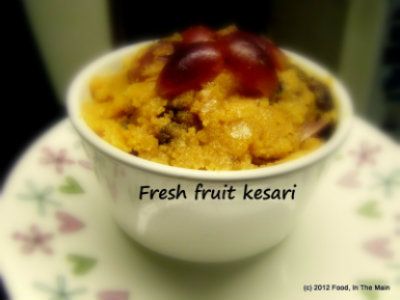
Ingredients:
1/2 cup rava/sooji/semolina
1-1/2 cups water
1/8 tsp saffron threads (a pinch) left to soak in 1/4 cup warm milk for 15 minutes
10-12 seedless red grapes, halved or quartered
1 small orange, peeled and segments chopped
1 small ripe banana, chopped
1 small ripe plum, stoned and chopped
1 tbsp raisins or sultanas (optional)
1/2 cup sugar
1/4 tsp cardamom powder
5 tsp ghee
2 tbsp nuts (I used walnuts and pecans)
Method:
1. Heat 2 tsp ghee in a heavy-based medium size pan and fry the rava/sooji/semolina on medium heat, stirring frequently, for about 5 minutes till the rava turns a slightly darker shade and smells roasted. Be careful that it doesn't burn. Remove to a bowl till required.
2. In the same pan, heat another tsp ghee and fry the nuts on medium heat, stirring till they are fragrant and turn a darker shade. Remove the nuts from the pan and reserve.
3. Heat the fourth tsp of ghee in the same pan, and add all the fruits, letting them cook on medium-low heat till they are soft and squishy, about 5 minutes.
4. Now add the water and sugar. Bring to a boil, then lower the heat a little and let it simmer for 5 minutes, stirring until the sugar dissolves completely.
5. Add the roasted rava/sooji/semolina now, stirring all the while to mix evenly. Let this cook until the kesari begins to thicken, then add the saffron milk and stir it in. Keep stirring frequently to ensure that it does not burn or become lumpy.
6. When the kesari is no longer watery and has "come together" in a soft mass, stir in the fried nuts along with the remaining tsp ghee. Serve the kesari warm in small bowls.
Tip: You can also spread the kesari on a greased plate and let it cool, then cut it into squares or diamonds for a more elegant (and convenient) presentation.
Powerhouse muffins - what else could you possibly call muffins that have, as part of the ingredients, peanut butter, mashed banana, fresh pineapple, flaxseed powder, toasted skin-on almonds, raw cauliflower...
Wait, what? Cauliflower? That smelly vegetable? In a sweet muffin? Oh yes, you read that right, people. This muffin recipe actually does have raw cauliflower as an ingredient. If you're like me, you'd be wondering why anybody would want to add cauliflower to a muffin. (If you're not like me and you routinely add inappropriate ingredients to your recipes and make a success of them, what are you doing reading this blog in the first place??? My conservative - in terms of mixing and matching food ingredients - blog will hold no surprises for you!)
But while I might not come up with weird and wonderful food ideas all on my own, I'm still capable of recognising weird and wonderful food ideas when I come across them on other blogs. And, assuming the weirdness and wonderfulness does not seem completely insane to me, I can be intrigued into trying out the weird and the wonderful for myself, just to see if the weird and the wonderful can actually come together and make something edible and tasty.
I really, really didn't think the muffins would turn out well - in the sense that they would appeal to my tastebuds, especially with me knowing about the cauliflower. (I would have preferred to make them without me knowing, to be honest, but I just couldn't bend reality enough. Should have tried harder, maybe...) I was doubtful about the muffins' edibility mainly because I'm not one of those people who eat dreadful-tasting things merely on the dubious grounds that they're "healthy". My healthy has to come strongly disguised as tasty, let me tell you.
Anyway, as I was saying, I was sufficiently taken up with the thought of trying out the muffins on Pete (what, did you think I'D actually eat one first???), so I went ahead and made them, with a couple of minor changes in ingredients and quantities. (The original recipe can be found here.) As it turned out, even if I'd wanted to be the guinea pig, Pete didn't give me the chance. He sneaked one while it was quite hot and still cooling on the countertop, and pronounced them "lovely". To be fair, they smelt really rather nice.
I let him eat the muffin fully and start on another before I said: "The muffins are nice, are they?"
"Oh yeah, really soft and fruity."
"Oh good," I said, happily. "So do you want to know what's in them?"
He regarded me suspiciously, mid-bite. "What? I suppose you're going to say it's something dreadful?"
"Depends on what you'd consider dreadful." I grinned at him. "It's got pureed cauliflower in it!"
He looked at the half-eaten muffin in his hand like it was an apple in which he'd found half a worm.
"Cauliflower?" he repeated in pained disbelief. "What in god's name made you think of making muffins with cauliflower?"
"It was a recipe I saw on a blog," I said. "Obviously it works, because you couldn't taste or smell the cauliflower. Glad you tasted it first, though."
He made a few noises like he was going to be sick, while swallowing the rest of the muffin. "For god's sake, don't sppring this sort of thing on me!" he grumbled.
And then he went back to the kitchen to get himself another muffin.
Recipe for: Powerhouse muffins
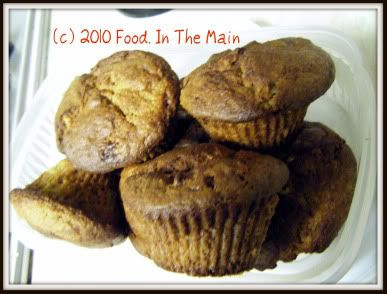
Ingredients:
1/2 (heaped) cup light brown sugar
1/4 cup peanut butter (I used chunky, and I'm glad I didnt use 1/2 cup as I found the peanut butter taste far too strong - and sort of overbaked, too, when I tasted a muffin)
1 large banana, mashed with a fork
1/2 cup raw cauliflower puree (leave out the stem, use just the "flowers" in the puree)
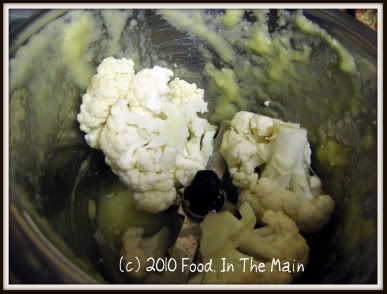
1/4 cup fresh pineapple puree
1 large egg
1 cup whole-wheat self-raising flour
1/4 cup powdered flaxseeds
1/2 tsp baking powder
1/2 tsp baking soda
2 tsp vanilla extract
15-20 skin-on almonds (toasted and chopped)
Method:
1. Heat oven to 180C/350F. Spray 12-cup muffin tray with non-stick spray or use silicone liners (which I sprayed anyway).
2. Mix brown sugar, flaxseed powder,
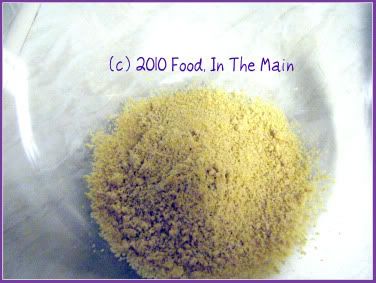
mashed banana, pineapple
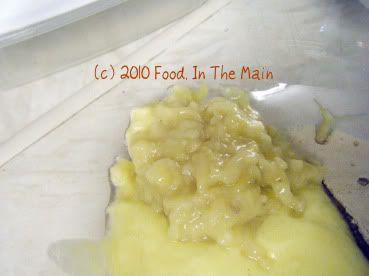
and cauliflower purees,
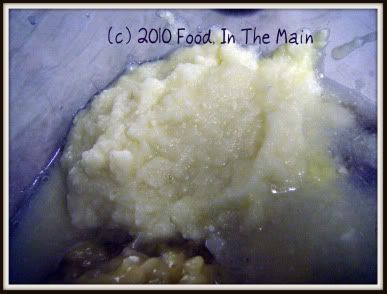
egg,
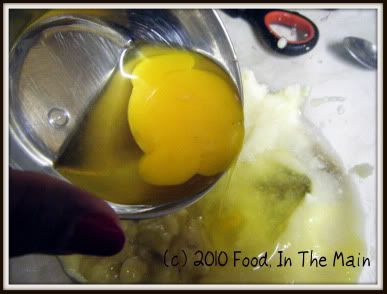
peanut butter,
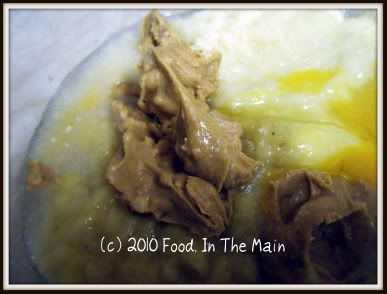
and vanilla extract. Mix well.
3. In a separate bowl, mix flour, baking power and baking soda.
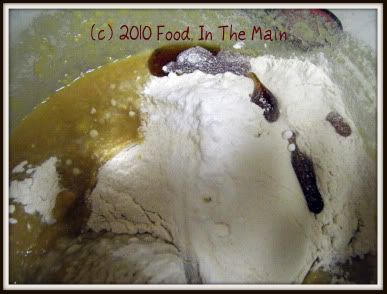
Pour into puree mixture, stirring just until mixed. The batter will be lumpy.
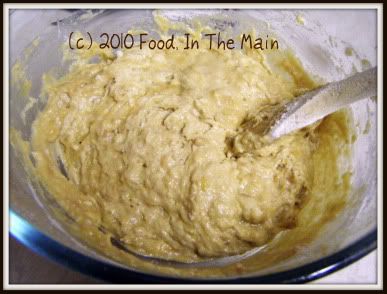
Lightly stir in the chopped toasted almonds.
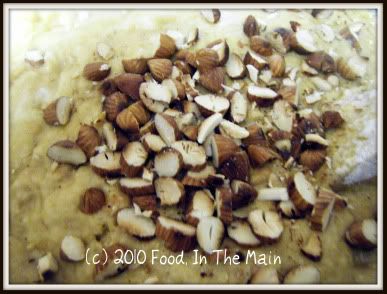
4. Divide batter into muffin cups and bake till the muffins are done (20 minutes or more, depending on your oven).
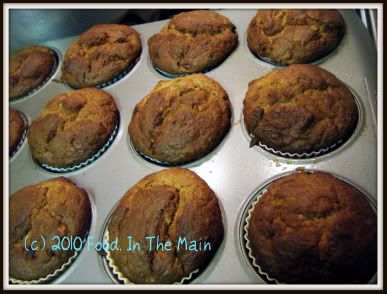
Test with a toothpick to check. Best served warm and fresh, but can be reheated to good effect in a microwave oven.
After a long time, I'm really excited about an eggless cake. This was originally called "apple pound cake", and arrived in my inbox a few months back. It called for horrendous amounts of eggs and sugar and butter, and although I saved the recipe because I wanted to play around with the ingredients and quantities, I didn't feel like making the effort to turn idle thoughts into action.
However, there were a few Granny Smith apples that had been in the refrigerator for weeks. They needed using up, but they didn't quite look appetising enough to eat (plus there were fresh eating apples which I'd bought, having forgotten about the Grannies!) So I hauled out my file book of "cakes to try" and chanced upon the apple pound cake recipe again... and my mother's presence here encouraged me to omit the eggs, so that she could eat the cake too. I used oil instead of butter, and substituted the eggs with mashed banana, and because I had run out of regular flour, I used self-raising flour. Then of course I wasnt sure how much baking powder/soda I should add to the flour to make up for the lack of eggs... all in all, let's say that I wasnt very certain of the cake's outcome.
Surprisingly, and very pleasingly, it was super moist and wonderfully flavourful - the moistness from the grated apple and the flavour because I'd used cinnamon and cardamom rather than vanilla extract. The layer of apples at the bottom (which became the top when the cake was inverted - oh, did I forget to mention that I made it an upside-down apple cake?) had caramelised just the tiniest bit from the sprinking of demerara sugar I'd added to the cake pan at the first. About 98% of the apples unmoulded cleanly from the pan, but the bits that were left in the pan tasted unbelievably gorgeous - which I scarfed down as cook's perk, naturally... All in all, the cake was great on its own with a cup of tea, and just as gorgeous warmed slightly and served with vanilla icecream. All in all, one of the nicest eggless cakes I've made despite my meddling with the instructions and ingredients!
Recipe for: Moist apple cake
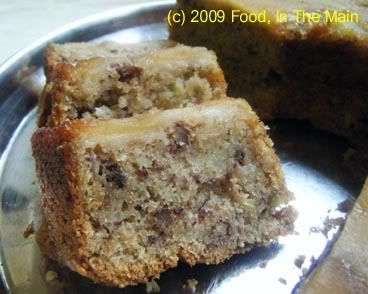
Ingredients:
3 Granny Smith apples
1-1/2 cups self-raising flour
1/2 tsp baking soda
1/4 tsp salt
1/2 tsp cinnamon powder
1/4 tsp cardamom powder
3/4 cup vegetable/sunflower oil
3/4 cup white sugar
3 tbsp demerara sugar
1 small ripe banana (to make 1/4 cup mashed)
1/4 cup chopped walnuts
2-3 tbsp milk
Method:
1. Grease an 8” tube pan. Sprinkle demerara sugar evenly over the bottom.
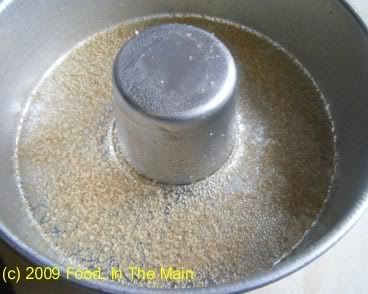
Preheat oven to 180C.
2. Peel and core apples.
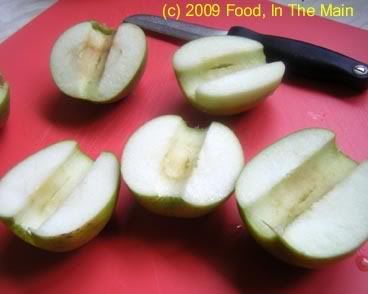
Slice one apple in half vertically, turn it a quarter circle and slice again into ¼ cm thick slices.
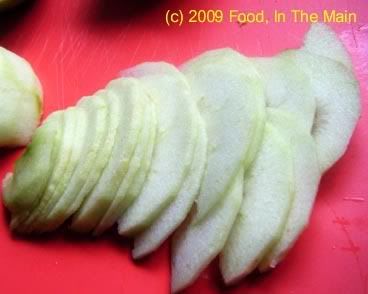
3. Grate the remaining apples and set aside, covered.
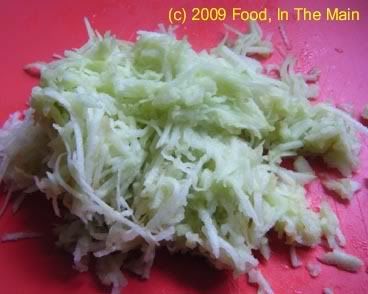
4. Combine flour, baking soda, cinnamon and cardamom powder and salt in a medium bowl.
5. In a large bowl, add the mashed banana, white sugar and vegetable oil.

Beat till well blended.
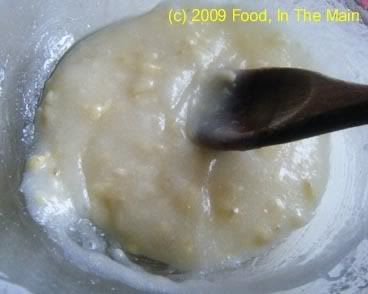
6. Add the flour in three or four stages, mixing well after each addition.
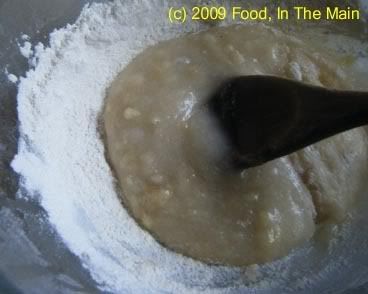
If the batter gets very thick, add a couple of tbsp milk to make it easier to mix. Don’t add too much milk, though - the grated apples will add enough moisture to the batter later.
7. Fold in the shredded apples
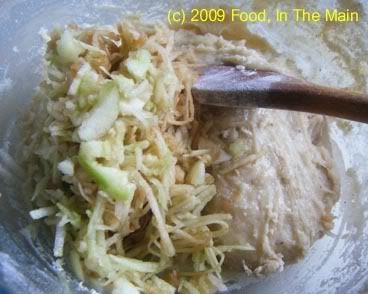
and chopped walnuts into the batter.
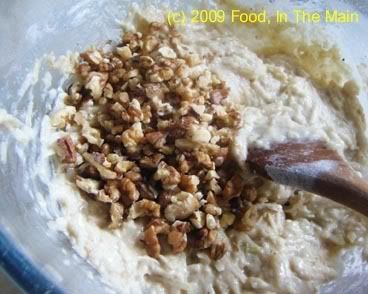
8. Arrange the sliced apples on the demerara sugar at the bottom of the pan, overlapping the slices slightly.
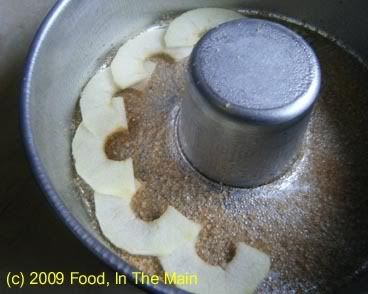
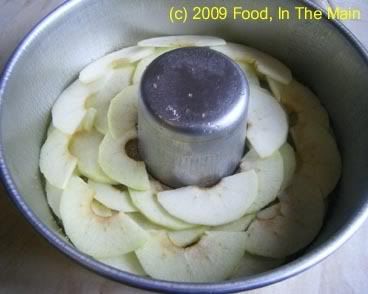
9. Spoon the batter evenly over the sliced apples and bake at 180C for 30 minutes.
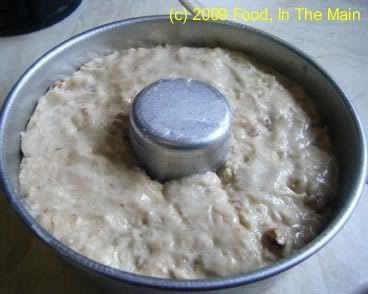
Check to see if the cake is done; if not, give it another five minutes (and a further 5 if required) and check again. The cake should have pulled away slightly at the edges.
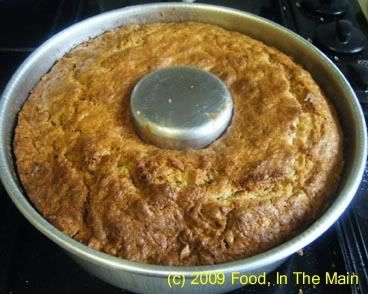
10. Cool the cake in the pan for 15 minutes, then carefully turn out onto a serving plate.
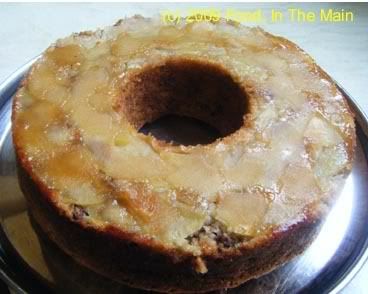
Let cool completely before slicing carefully.
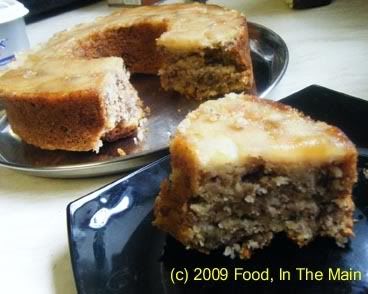
Serve with vanilla icecream or thick cream, if desired.
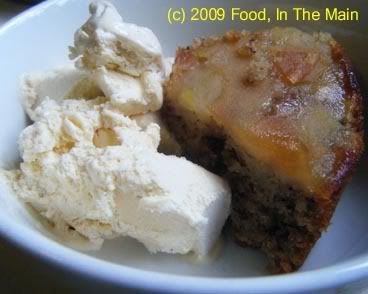
The nice thing about this bread-and-butter pudding is that it needs only 1 tbsp sugar – the natural sweetness of bananas, sultanas and currants more than suffices, especially for those without a sweet tooth the size of Ayers Rock. And if you don’t wish to use even that 1 tbsp sugar (mainly to sprinkle on top, for caramelisation purposes), well, this becomes an entirely processed-sugar-free recipe. Not bad for a dessert, is it? Serve this pudding with sugar-free or low-sugar icecream, or light cream, and the sin points still wouldn’t add up as much as from, say, a slice of frosted chocolate cake with cream.
Pete, as usual, doesn’t like desserts which combine eggs and milk – even if the end result isn’t as custardy as custard-from-scratch. To his credit, he did try a spoonful of this banana bread-and-butter pudding and pronounced it “very tasty”… but it still didn’t encourage him to go for a separate portion of his own. Which is okay, because I’ll get to have this over the next 4 days. It makes for a pretty small(ish) pudding – three reasonable servings, or four small ones, or two large greedy ones. All without the addition of icecream, that is.
It would be best to use slightly overripe bananas in this recipe, as there is no extra sugar added (worth saying again, I think!). Served warm, this pudding is really rather nice on a cold evening. Recipe for: Banana bread-and-butter pudding
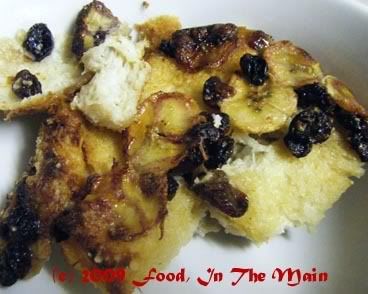
Ingredients:
4 slices bread
1 tbsp butter
3 tbsp sultanas
3 tbsp currants
1 large ripe banana, sliced
1 tbsp demerara sugar
1 tsp vanilla extract
1 egg
1 cup (225ml) milk
Method:
1. Beat the egg and milk together with the vanilla extract. Reserve.
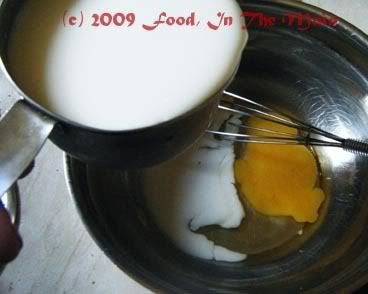
2. Cut the crusts off the bread.
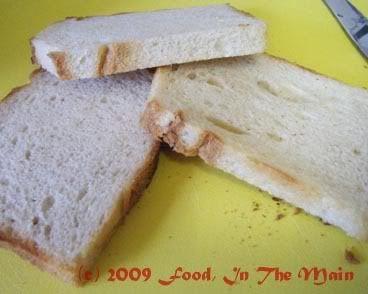
3. Lightly butter one side of each slice and cut each slice into four.
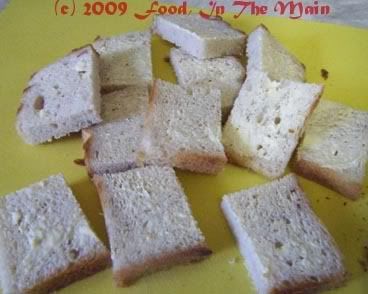
4. Mix the sliced bananas with the sultanas and currants.
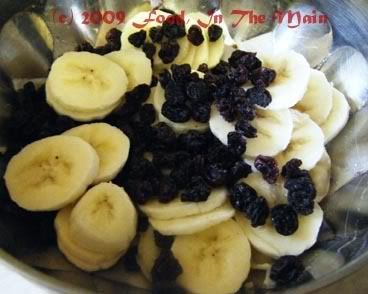
5. Butter a 1-litre baking dish lightly. Arrange half the pieces of bread, buttered side up, in the bottom of the baking dish.
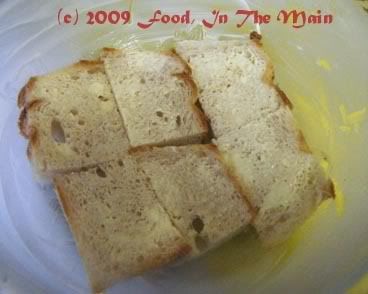
6. Spoon half the banana-sultana mix over the bread.

7. Pour half the milk mixture over this, making sure to cover all the bread. Sprinkle 1/2 tbsp demerara sugar over.
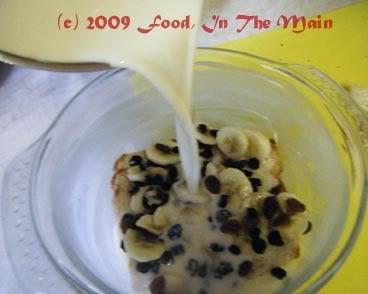
8. Layer the remaining pieces of bread, buttered side up again,
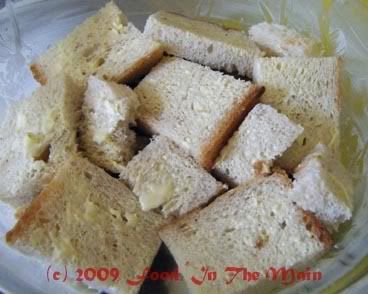
then the remaining banana slices,
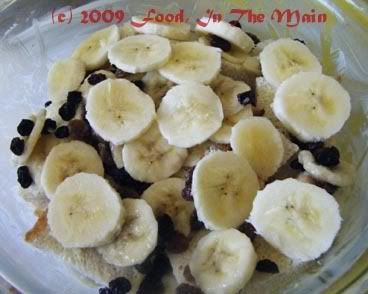
and pour the rest of the milk over.
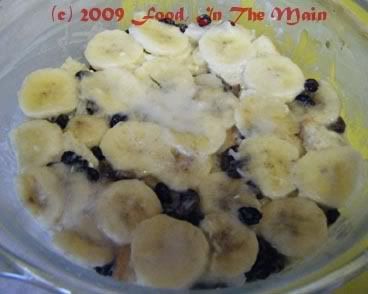
Sprinkle the remaining 1/2 tbsp of demerara sugar over the top.
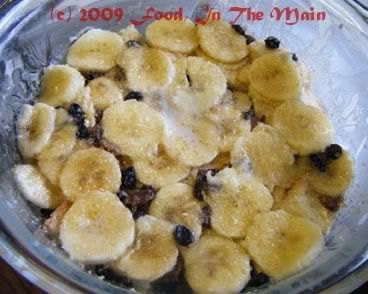
9. Press down gently and evenly to make sure that the bread pieces are all covered by the milk. Allow to soak for at least 30 minutes in the fridge.
10. Heat the oven to 180C and bake the pudding for 30-40 minutes or till the top layer of banana pieces are caramelised and the bread turns golden brown.
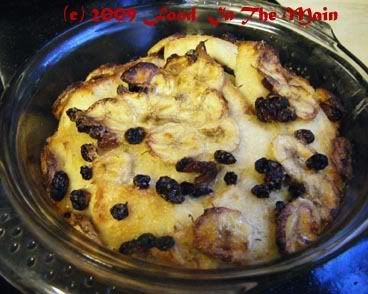
11. Serve warm as is, or with ice-cream or cream, if preferred.

If anybody out there is wondering if plantain chips are better baked from raw or baked from parboiled, I have the answer: It doesn’t matter much either way. And if that same person (or persons) - or a different person (or persons) – is also wondering if they taste good when overbaked, the answer is a resounding NO.
Overbaking these chips is a bad, bad idea because then they turn into something resembling wood chips in looks, texture and taste. They’re very, very hard on the teeth (for obvious reasons), but what you might not know is that they’re also murder on the eardrums - because the noise that results in your head when you crunch them is off the decibel scale altogether. You can’t hear anything else for a while, so you get some quiet time to reflect on whether you’ve just shattered a plantain chip or your favourite chewing tooth, and come to the realisation (for the nth time) that it’s a bad idea to leave the kitchen and settle down with a book while the oven is on and an even worse idea to forget about what’s in the oven…
(Modus operandi in case of absent-minded overbaking:
1. Suddenly remember chips in oven.
2. Rush to oven and open the door.
3. Rear back from the rush of smoke and heat, bang the oven door shut.
4. Switch off the oven.
5. Search frantically for a magazine or a newspaper to wave at howling smoke detector in the foyer and hopefully stop the noise before some neighbour calls the firemen.
6. Open the doors and windows to get rid of the smoke.
7. Rush back to smoke detector and wave at it some more, cursing its sensitivity. 8. Cautiously return to oven to check on the condition of plantain chips within.
9. Repeat Step 7, but with more cursing.
10. Throw away burnt offering and restart baking procedure with second batch of parboiled plantains.)
Optional – Put away temptingly readable book for the duration. If not, see procedure as above.
Notwithstanding the above, if you do it right, you do get crunchy - but not deafening - plantain chips. Never as tasty as the fried kind, but definitely on the right side of palatable.
PS. I deep-fried a small handful of the parboiled plantains… and oh boy oh boy, were they goooooood! (My friend A, visiting at the time, might be able to endorse that. She missed the original burning ceremony, luckily for her.)
Recipe for: Oven-baked plantain chips - 2
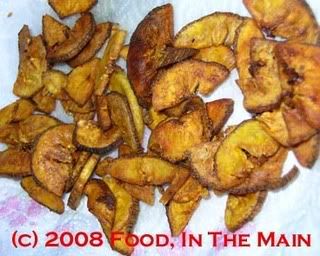
Ingredients:
1 large plantain, lightly peeled, sliced 1/4 cm thick
2 tbsp oil (or oil spray)
Salt to taste
Spices to taste
Method:
1. Parboil the plantain slices by putting them in boiling water for 5-6 minutes.
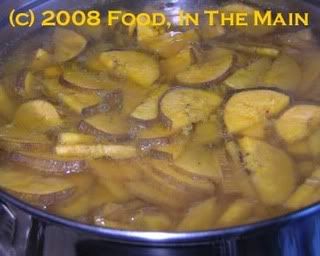
2. Drain water, pat slices reasonably dry with paper towels.
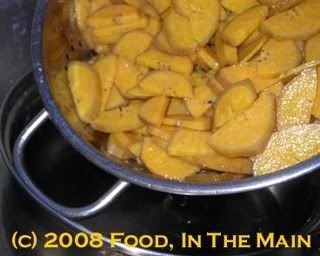
3. Line a baking tray with foil, spray foil with Pam or other cooking spray.
4. Toss the plantain slices with salt, spices and oil in a bowl, then spread on the prepared tray.
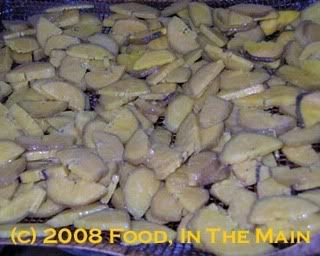
5. Bake at 180C (350F), turning the chps over after 12 minutes,
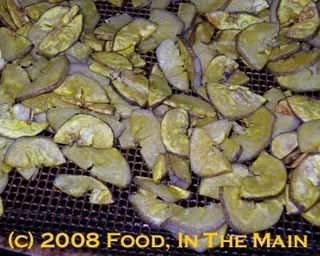
to crisp them evenly. Remove when done, cool and store in an airtight box.

It isnt often that I take part in the cooking events that occur so regularly in the food blog world. But sometimes - just sometimes - thought and deed come together in a happy coincidence with a new event to which I can contribute... and this time it's the JFI: Banana event announced by Mandira of Ahaar. And as everybody knows, the event originated from Indira of Mahanandi and has been taken up faithfully every month by various food bloggers.
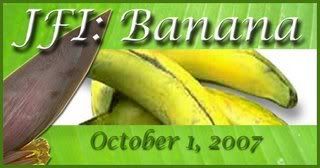
I didnt know the banana would be the topic for September's JFI.. but it turned out very lucky - both because I love bananas and because I have a lovely banana bread recipe that I fortunately tried out just yesterday.
I might just be the first person to send an entry to Mandira for this JFI - I hope so anyway! Of course this means I have to wait pretty much an entire month before I can see the round-up... but I guess that is the drawback to being an early bird!
Recipe for: Nutty curranty banana bread

Ingredients:
1/4 cup margarine/butter
1/2 c. sugar
1-1/2 cups flour (I used 3/4 cup ap flour and 3/4 whole wheat))
1/3 tsp. salt
1 egg (optional - can be replaced with another mashed banana)
1-1/2 tsp baking powder
1/4 tsp baking soda
1/4 cup chopped nuts (I used brazil nuts and pecan nuts)
1/2 cup currants
1/4 cup milk (if required)
2 large ripe bananas, mashed with a fork
2 tsp vanilla extract
1. Cream together the butter/margarine and sugar.
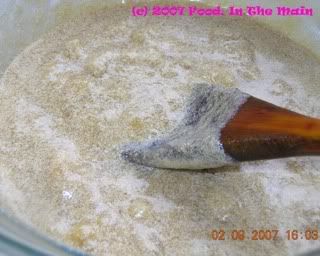
2. Add the egg and beat well (if using). Otherwise add mashed bananas, currants and chopped nuts and mix.
3. Sift together the flour, salt, baking powder and baking soda.
4. Pour the banana mix into the flour and mix lightly. If batter seems too thick or there isnt enough liquid, add 1/4 cup milk little by little to get a pourable (but still thick) consistency.
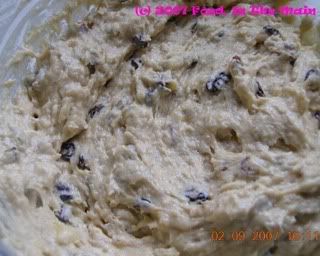
5. Pour into 8x4x3 inch loaf pan sprayed with Pam.
6. Bake at 350 degrees for 45 minutes or till the bread tests done (it should have pulled away from the sides a little).
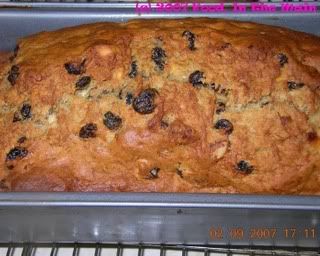
7. Cool on wire rack 10 to 15 minutes before removing from pan.
8. Complete cooling and store overnight, wrapped in clingwrap, before cutting.
